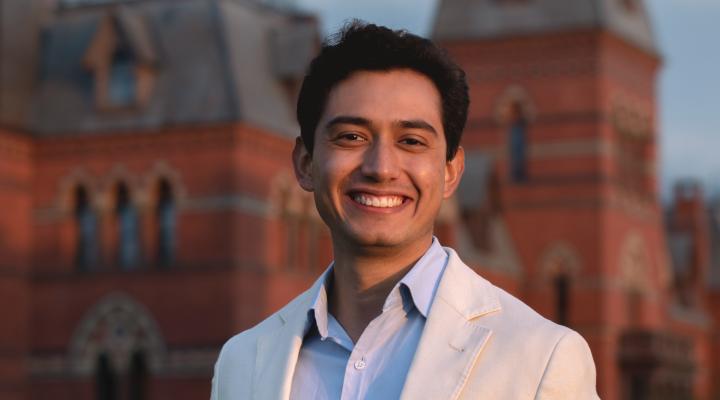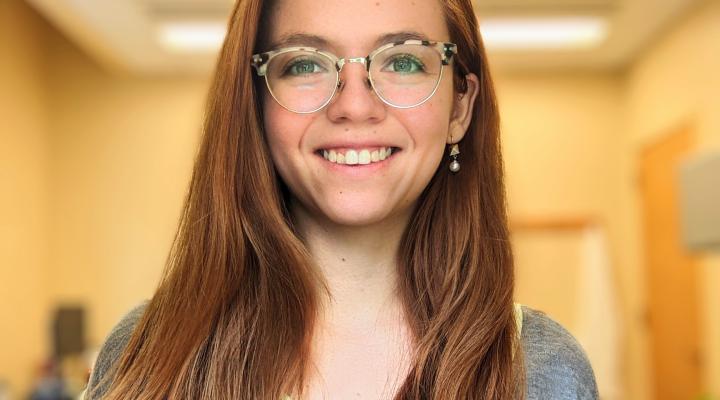With a generous gift from Nancy and Samuel Fleming ‘62 to support graduate student research in the biomolecular program, the department selects students each year to be named "Fleming Scholars." Through a competitive process, the fellowships are awarded to outstanding Ph.D. students pursuing research in biomolecular engineering and who have distinguished themselves as promising scholars in their particular field. The scholars were evaluated by select biomolecular faculty members on the basis of their research productivity and career/professional development. The Fleming Scholars for 2020-2021 are named below with a description of their current research:
Meghan O'Leary, Alabi Group
Bacteria’s ability to rapidly evolve into antibiotic-resistant strains presents an imminent threat to global health and an urgent need to develop new classes of antimicrobial agents. People with compromised immune systems, such as those with the genetically inherited respiratory tract disease cystic fibrosis (CF), are particularly vulnerable to these resistant pathogens. Pseudomonas aeruginosa is one of the primary antibiotic-resistant threats to CF patients. It is a Gram-negative, opportunistic bacterium, whose treatment is further complicated by its ability to aggregate into enduring biofilms. The last resort for treating multidrug-resistant (MDR) P. aeruginosa and other Gram-negative bacteria is a class of antibiotics called the polymyxins; however, polymyxin-resistant isolates have already surfaced. In response to this crisis, antimicrobial peptides (AMPs) and their synthetic mimetics have been investigated as alternative therapeutic options. One class of AMP mimetics that has shown potent activity against both Gram-positive and Gram-negative bacteria is oligothioetheramides (oligoTEAS), which are synthetic, sequence-defined, cationic oligomers synthesized through rapid, orthogonal chemical reactions. A promising oligoTEA known as BDT-4G has been tested to evaluate its antibiotic potential against MDR bacteria. BDT-4G offers a therapeutic advantage over the polymyxins as it can evade mechanisms conferring resistance to these agents. Analogous to other AMP mimetics, however, BDT-4G exhibits systemic toxicity in vivo. To mitigate toxicity, Meghan’s work in the Alabi lab assesses a prodrug methodology whereby polyethylene glycol (PEG) is conjugated to BDT-4G via a bacteria-susceptible, cleavable substrate. Antibacterial activity is recovered after site-specific cleavage of the linker by LasA, a secreted bacterial protease. This strategy concurrently reduces cytotoxicity and provides strain specificity, and it can be facilely translated to target other strains of bacteria by altering the linker.
Tiffany Tang, Daniel Group
Tiffany’s research in the Daniel group investigates the entry processes of human pathogenic coronaviruses (CoV), including severe acute respiratory syndrome coronavirus (SARS-CoV), Middle East respiratory syndrome coronavirus (MERS-CoV), and the severe acute respiratory syndrome coronavirus 2 (SARS-CoV-2). CoV are a family of enveloped viruses that cause a variety of respiratory and/or enteric tract infections. The pandemic caused by SARS-CoV-2 as well as outbreaks caused by SARS-CoV and MERS-CoV have highlighted the dangers that CoVs pose to human health. As there are no commercially approved vaccines or therapeutics against CoV, it is important to study CoVs to control CoV outbreaks. A critical step in CoV infection is viral entry, in which the viral fusion peptide (FP) mediates viral-host cell membrane fusion so the virus can infect. The FP is amongst the most conserved region across the CoV family, meaning that trends observed for one CoV will likely apply to other CoVs, even for CoVs that are yet to emerge. The main themes of her research include determining CoV fusion mechanisms, designing CoV anti-fusion strategies, and developing viral fusion detection platforms. Tiffany hopes to contribute to a greater understanding of CoV entry and use that knowledge to develop novel therapeutic and detection strategies.
Natalia Lopez-Barbosa, DeLisa Group
Antibodies (Abs) are large, Y-shaped glycoproteins produced by plasma cells in the immune system that neutralize pathogens during infection. These molecules recognize motifs (antigens or epitopes) on the surface of the pathogen through the fragment antigen-binding (Fab) variable region. Once bound to an antigen, they also serve as “tags” for other effector cells of the immune system to clear an infection. Abs are secreted by plasma cells created after the differentiation of immature B cells during what is known as the humoral immune response. The B cell pool consists of several populations that are segregated anatomically, developmentally, and functionally. Among these, B1 cells secrete what is known as “natural” Abs, which are produced in the absence of deliberate immunization and without requiring interaction with T cells. My project seeks to understand the role of B1 cells in the secretion of Abs that recognize carbohydrate structures (a.k.a. glycans) and how these Abs might be directly involved in the development of autoimmune reactions.
Natalia’s work in the DeLisa lab hypothesizes that the immune responses to glycans are T cell-independent and are governed by B1 cells, even when the glycan epitope is not seen as “self.” Additionally, she thinks that the immune response to self-glycans is driven by monoclonal idiotypes. Although B1 cells have been shown to interact with foreign (i.e., bacterial or viral) glycans through a T cell-independent response, and to differentiate into Ab-secreting cells through innate signaling, their behavior outside of inflammation is poorly understood. Although Abs present in blood sera of humans and mice have been shown to react with multiple glycan epitopes, their origin, sequences, and functionality have yet to be elucidated. Relatively few Ab sequences are known to recognize glycans, especially when compared to their protein-recognizing counterparts. This is due to a lack of understanding regarding both the fundamental immunology of anti-glycan Abs and how to steer the immune system towards an anti-glycan response. Natalia’s work will contribute to filling this gap in knowledge by screening and isolating anti-glycan Abs from different B cell populations of the immune system.





